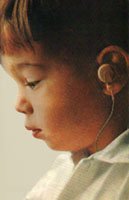Hearing Impairment

Definition
Hearing loss can be of different degrees varying from total deafness to hard of hearing. Early detection of hearing loss is very crucial because of the vital association between hearing and speech and language problems.
Characteristics
Detection mainly depends on careful observation of the child over the first eight months of life. For the first 2-3 months, the infant will develop quite normally. After the 3-4 months, the normal child makes different types of sounds. By 8 months, he listens to speech, babbles and squeals. The child tries to copy the rhythm and pattern of the sound in speech. In the case of hearing impaired child, this does not happen. Then, careful examination by an experienced doctor should be carried out.
The child will be indifferent to the sound, he will have monotone quality of speech, loud gestures and tantrums to attract attention. In case of partial loss, the child may appear lazy, inattentive and confused.
Causes
Like in all disabilities, prenatal, perinatal & post natal factors can cause deafness. German Measles & Mumps affect the foetus. Perinatal causes: Forceps delivery, lack of oxygen in times of prolonged labour. Postnatal causes: Diseases in childhood such as mumps, measles.
Types
Accumulation of wax or infections can prevent the sound waves from reaching the inner ear. The reduction in the intensity of the sound can cause hearing loss. This is called Conductive deafness. It can be medically treated. These children can be helped by means of hearing aids. Perceptive deafness is caused by permanent damage to the nerve endings of the inner ear. “Hearing Impairment” means loss of sixty decibels or more in the better ear in the conversational range of frequencies.
Classification
The children are also classified as congenitally deaf & children with late onset. Hearing loss is measured in decibels.
The sound of ordinary conversation is about 60 - 70 decibels.
| 1. | Mild loss | 20 - 30 decibels |
| 2. | Marginal loss | 30-40 decibels |
| 3. | Moderate loss | 40 - 60 decibels |
| 4. | Severe loss | 60 - 75 decibels |
| 4. | Profound loss | More than 75 decibels |
Treatment
Management
Technology is the backbone of the treatment program in hearing disability. Hearing disability relies heavily on hearing aids, amplifiers, specialised equipment’s for educational program etc. For optimum results, diagnosis of level of hearing loss and suitable corrective technology is very important. Cochlear Implant is a solution for some people with hearing impairment.
Integration of the child will depend on
- 1. Degree of loss - children with mild loss can be taught in regular classrooms with conducive atmosphere & seating arrangements. Marginal loss can be treated with speech training & hearing aids. For moderate loss, hearing aids, amplification of auditory stimuli & use of visual aids are used.
For severe and profound loss specialised techniques are used. - Age of onset (a beginning) plays a very important role in determining the development of speech & language acquisition in a child. If the child has developed a speech pattern, then his educational program will differ from that of a child who has not developed speech at all.
- Type of loss - The speech training will change depending on the type of loss. For conductive loss the child speaks too softly and for perceptive loss, he, speaks too loudly.
- Any other associated disability like vision impairment will certainly pose limitations in instructional material presented to the child and the methods will vary.
Early Training
The early training consists of teaching the parents, especially the mother, on how to teach the child. The parents are primarily taught that the communication should be intelligible to the child. He should be able to gather clues from parent's lip movements, facial expressions, nods etc& associates with their meaning. An appropriate action should be associated with the speech to make the message understood. This is the combination of two theories of teaching the Hearing Impaired.
- Oral Method - which communicates through speech and lip reading
- Manual Method - which communicates through signs & gestures. Another form is using fingers in a fixed manner to depict an alphabet i. e finger spelling. There are also other methods like Total communication, Makaton etc.
Tips to parents
- While speaking, face the child so he can see you, your facial expressions andbody movements.
- Proper light arrangement to read your lips.
- Do not talk fast and at the same time make sure not to exaggerate the lip movements.
- Allow the child to touch when you speak to know the source point of the sound and to feel the vibrations.
- Encourage the child to speak as much as possible.
Speech Disorder
Hearing and Speech Development go hand in hand.
Definition
Speech Disorder is a defect or abnormality that prevents an individual from communicating by means of spoken words.
For normal Speech Development these things are necessary.
1. Normal development of the ear and larynx.
2. Conducive home environment for the child to receive and share his ideas.
(Here the focus is mainly on the speech disorder developed due to hearing handicap).
The best period to learn speech is first 3 or 4 years of life. So pre-school period spent at home is very important. Due to hearing impairment speech defects like staccato speech problems (found in CP children), stammering, monotonous speech pattern can be developed. If a child with hearing impairment masters his speech, he can be integrated more readily into the mainstream society and will not face isolation problems.
